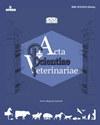马的嗜吞噬细胞无原体-促炎生物标志物的评价
IF 0.2
4区 农林科学
Q4 VETERINARY SCIENCES
引用次数: 2
摘要
背景:吞噬细胞无浆体是一种由蜱传播的专性细胞内病原体,可引起马粒细胞无浆细胞病(EGA)。这种病原体主要感染血细胞,主要是粒细胞,尤其是中性粒细胞。A.嗜吞噬细胞导致马患急性发热性疾病,伴有嗜睡、食欲不振、跛行和出血。在马身上,通过血液学检查发现的所有伴有血小板减少和白细胞减少的急性症状都应考虑这种疾病。蜱传病原体对动物和公众健康的威胁越来越大,因为蜱虫大多携带大量有充分记录和未记录的病原体,近年来蜱虫的地理范围有所扩大。本研究旨在评估嗜吞噬细胞A.感染对马的一些氧化/亚硝化应激参数、抗氧化酶活性、促炎生物标志物和微量元素水平的影响。材料、方法和结果:本研究使用93匹1岁及以上马的血液样本进行。将血样离心并分离血清。血清样本储存在冰箱(-20°C)中,直到分析当天。从血液中提取DNA,用巢式聚合酶链式反应技术靶向嗜吞噬细胞A.16S rRNA基因进行分析,然后对阳性产物进行测序。A.嗜吞噬细胞有6匹马(6.4%)的巢式PCR结果呈阳性。根据PCR分析结果,由6匹阳性马组成的感染组也选择了6匹健康马作为对照。血清SOD(马超氧化物歧化酶(Cu-Zn))ELISA试剂盒、MPO(ELISA试剂盒马髓过氧化物酶)和GPx(马谷胱甘肽过氧化物酶1 ELISA试剂盒)、IL1(马白细胞介素1βELISA试剂盒。采用比色试剂盒法测定血清TAS、TOS葡萄糖-6-磷酸脱氢酶(G6PD)水平。过氧亚硝酸根的测定采用Vanuffelen所述的分光光度法进行。采用电感耦合等离子体OES分析了Fe、Zn、Se、Cu、Mn、Ar、Cr、Co、Cd、Ni和Pb元素的含量。吞噬细胞A.感染阳性组的总氧化剂状态(TOS)和过氧亚硝酸盐水平高于对照组(分别P<0.05)。总抗氧化状态(TAS)、谷胱甘肽过氧化物酶(GPx)、超氧化物歧化酶(SOD)、G6PD和髓过氧化物酶(MPO)水平均显著高于对照组(P<0.05)。Cu、Mn、Se和Zn水平在感染组中也较低(分别P<0.05)。嗜吞噬细胞A.感染组促炎标志物中的IL1、IL6、TNFα和IL18升高(分别P<0.05)。讨论:关于宿主-寄生虫相互作用的促炎生物标志物的评估已被认为是确定感染严重程度和诊断疾病的有益临床工具。总之,通过对嗜吞噬细胞无浆细胞引起的马感染进行的多生物标记物分析评估,氧化应激增加和一些促炎生物标志物的高水平将有助于诊断、治疗和阐明发病机制。关键词:无浆体病,EGA,蜱传病原体,促炎细胞因子,抗氧化剂,氧化/亚硝化应激,马。本文章由计算机程序翻译,如有差异,请以英文原文为准。
Anaplasma phagocytophilum in Horses - Evaluation of Proinflammatory Biomarkers
ABSTRACTBackground: Anaplasma phagocytophilum is an obligate intracellular pathogen transmitted by the ticks that cause equine granulocytic anaplasmosis (EGA). This pathogen is infects predominantly blood cells, principally granulocytes and especially neutrophils. A. phagocytophilum causes an acute febrile disease in horses accompanying with lethargy, loss of appetite, lameness and hemorrhages. In horses, this disease should be considered in all acute symptoms accompanied by thrombocytopenia and leukopenia identified by hematological test performed. Tick-borne pathogens have become increasingly threatening for both animals and also public health since ticks mostly carry numerous well-documented and undocumented pathogens, and the geographical range of ticks has expanded in the recent years. This research has aimed to evaluate the impact of A. phagocytophilum infection on some oxidative/nitrosative stress parameters, antioxidant enzyme activities, proinflammatory biomarkers and trace element levels in horses.Materials, Methods & Results: The present study has been carried out using blood samples collected from 93 horses aged 1-year and older. The blood samples were centrifuged and sera were separated. Serum samples stored in the freezer (-20°C) until the day of analysis. The DNA was extracted from blood and analysed by nested-PCR technique targeting 16S rRNA gene of A. phagocytophilum and then positive PCR products were sequenced. A. phagocytophilum was 6 horses (6.4%) showed positive nested-PCR results. An infected group comprised of 6 positive horses according to PCR analysis results also 6 healthy horses as control were selected. Serum SOD (Horse Superoxide Dismutase(Cu-Zn)) ELISA Kit, MPO (ELISA Assay Kit Horse Myeloperoxidase) and GPx (Horse glutathione peroxidase 1 ELISA Kit Assay), IL1 (Horse Interleukin 1 Beta ELISA Kit), IL6 (Horse Interleukin 6 ELISA Kit), TNF α (Horse Tumor Necrosis Factor Alpha ELISA Kit) and IL18 (Horse Interleukin 18 (IL18) ELISA Kit) levels were determined by ELISA reader. Serum TAS ,TOS Glucose-6-phosphate dehydrogenase (G6PD) levels were determined using colorimetric kit method. The determination of peroxynitrite was performed using spectrophotometry as described by Vanuffelen. The levels of Fe, Zn, Se, Cu, Mn, Ar, Cr, Co, Cd Ni and Pb elements were analyzed by ICP-OES. Total oxidant status (TOS) and peroxynitrite levels of the positive group infected with A. phagocytophilum were found to be higher compared with the control group (P < 0.05, respectively). Whereas, total antioxidant status (TAS), glutathione peroxidase (GPx) ,superoxide dismutase (SOD), G6PD and myeloperoxidase (MPO) levels were detected to be statistically significantly higher than the control group (P < 0.05, respectively). Cu, Mn, Se and Zn levels were also found to be lower in the infected group (P < 0.05, respectively). IL1, IL6, TNFα and IL18 from proinflammatory markers were elevated in the A. phagocytophilum infected group (P < 0.05, respectively).Discussion: The evaluation of the proinflammatory biomarkers with respect to host-parasite interactions has been suggested as a beneficial clinical tool for determination of the infection severity and diagnosis of the disease. As a conclusion, increased oxidative stress and high levels of some proinflammatory biomarkers assessed by the multibiomarker analysis carried out for the infection in the horses caused by Anaplasma phagocytophilum will provide a contribution to diagnosis, treatment and clarification of the pathogenesis.Keywords: anaplasmosis, EGA, tick-borne pathogens, pro-inflammatory cytokine, antioksidant, oxidative/nitrosative stress, equine.
求助全文
通过发布文献求助,成功后即可免费获取论文全文。
去求助
来源期刊

Acta Scientiae Veterinariae
VETERINARY SCIENCES-
CiteScore
0.40
自引率
0.00%
发文量
75
审稿时长
6-12 weeks
期刊介绍:
ASV is concerned with papers dealing with all aspects of disease prevention, clinical and internal medicine, pathology, surgery, epidemiology, immunology, diagnostic and therapeutic procedures, in addition to fundamental research in physiology, biochemistry, immunochemistry, genetics, cell and molecular biology applied to the veterinary field and as an interface with public health.
The submission of a manuscript implies that the same work has not been published and is not under consideration for publication elsewhere. The manuscripts should be first submitted online to the Editor. There are no page charges, only a submission fee.
 求助内容:
求助内容: 应助结果提醒方式:
应助结果提醒方式:


